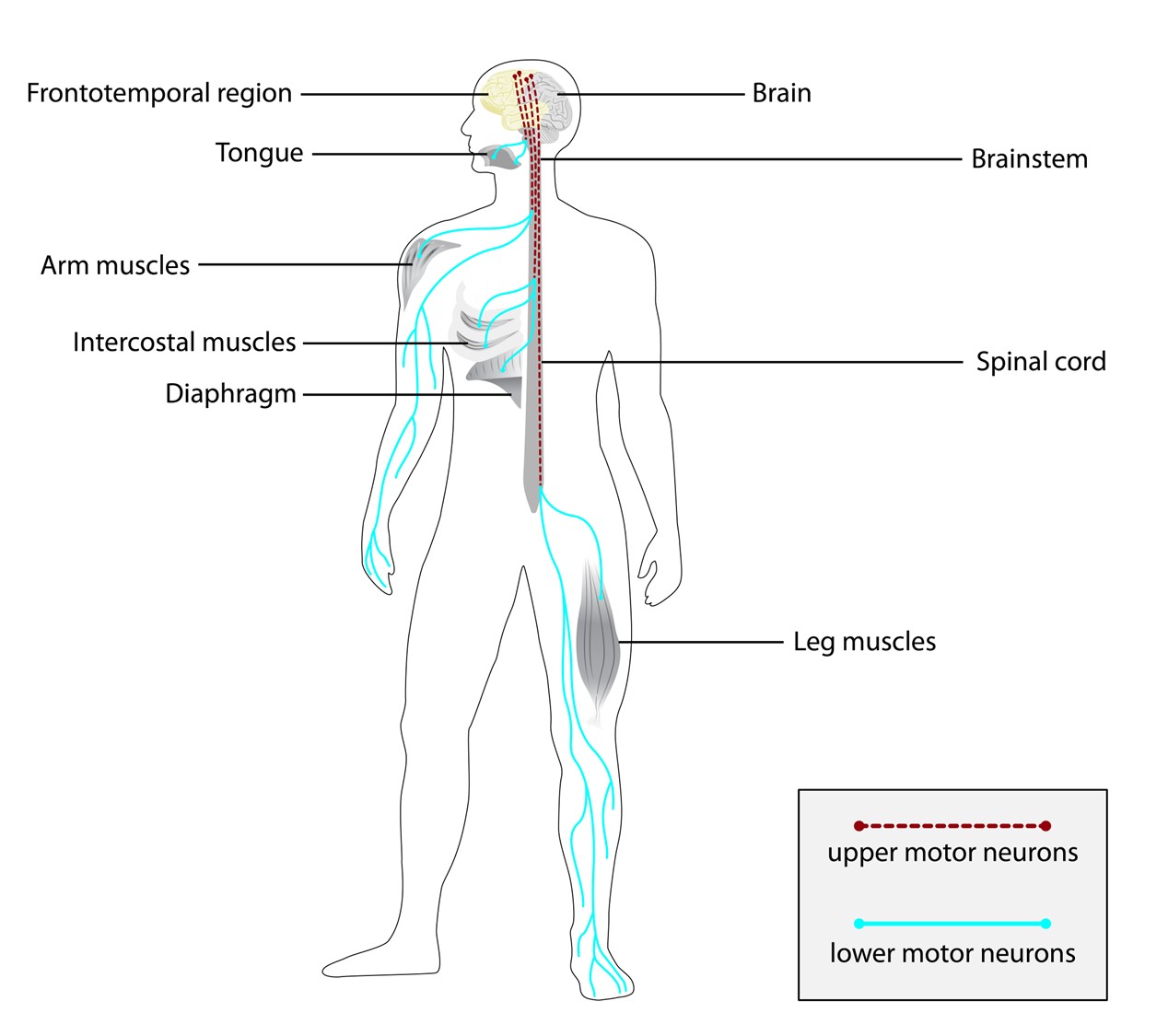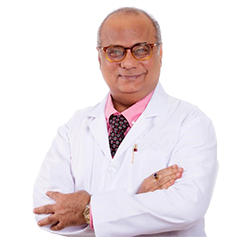
What is Motor Neuron Disease?
Best treatment for Motor Neurone Disease, firstly we have to know what it is - Motor Neuron Disease (MND) is an inclusive term used for a group of neurodegenerative conditions, which lead to relentless ubiquitous weakness and shrinkage of muscles.
Motor neurons are nerves that innervate muscles, and carry signals from the brain and spinal cord to control them. Upper motor neurons (UMNs) arise from the parent cells in the gray matter of the brain and transmit their signals to the lower motor neurons (LMNs) through anterior horn cells of the spinal cord. These lower motor neurons travel further onto the voluntary muscles of the body.
In MND, both groups of neurons, upper (UMN) and lower (LMN) slowly become thin and die. In absence of signals from the brain, the muscles supplied by these nerves including the tongue, chewing, swallowing, and breathing functions shrink in size and become progressively weak.
Types of MND
There are four different variants of MND. They all share the fundamental feature of motor neuron degeneration; however, they vary in their range and degree of symptoms, as well as disease progression.
Like most neurodegenerative diseases each individual experiences the disease differently; some present with all the symptoms, while others suffer from only a few.
The pattern and location of motor neuron deterioration is used to classify the disease into four main types. As the disease progresses, patients often develop degeneration of both the UMNs and LMNs, though only either UMN or LMN nerves may have been affected, to begin with. For the MND treatment in Dubai connect to bestneurologistdubai.com
Best Treatment for Amyotrophic Lateral Sclerosis (ALS)
ALS or Lou Gehrig's disease is the most common form of the disease and makes up 80-90% of cases. The French neurologist Jean-Martin Charcot coined the term amyotrophic lateral sclerosis in 1874. Motor neurons are grouped into upper populations in the motor cortex and lower populations in the brain stem and spinal cord; lower motor neurons innervate muscles.
When corticospinal (upper) motor neurons fail, muscle stiffness and spasticity result. When lower motor neurons become affected, they initially show excessive electrical irritability, leading to spontaneous muscle twitching (fasciculations); as they degenerate, they lose synaptic connectivity with their target muscles, which then atrophy
Both UMNs and LMNs are affected, leading to loss of control of the voluntary muscles. Initially, the patient presents with symptoms of limb muscle weakness, stiffness, and spasms. Individuals increasingly trip while walking, or drop things.
As the disease progresses, other muscles deteriorate, such as those for speech, swallowing, and breathing. Patients also experience unstable and rapidly changing emotions. ALS typically begins in the limbs, but about one third of cases are bulbar, heralded by difficulty chewing, speaking, or swallowing. Until late in the disease, ALS spares neurons that innervate the eye and sphincter muscles.
The diagnosis is based primarily on clinical examination in conjunction with electromyography, to confirm the extent of denervation, and laboratory testing, to rule out reversible disorders that may resemble ALS.
From the onset of symptoms Amyotrophic Lateral Sclerosis Treatment Dubai, the life expectancy for ALS is between 2-5 years. Patients typically die as a result of failure of the respiratory muscles. Around 10% of individuals with ALS survive for more than 10 years, as seen with the late theoretical physicist, Stephen Hawking, who lived on for another 55 years.
Diagram of a human highlighting the areas affected by amyotrophic lateral sclerosis (ALS) including the upper motor neurons, lower motor neurons, and frontotemporal region of the brain, along with the muscles affected as a result.


During the past two decades, it has been recognized that 15 to 20% of persons with ALS have progressive cognitive abnormalities marked by behavioral changes, leading ultimately to dementia.
Since these behavioral alterations correlate with autopsy evidence of degeneration of the frontal and temporal lobes, the condition is designated frontotemporal dementia. It was formerly called Pick’s disease. If you are looking for the best ALS treatment center in Dubai contact to Best Neurologists Dubai.
Progressive Bulbar Palsy (PBP)
PBP affects 4.1% of individuals with MND. This variant affects the motor neurons in the bulbar region of the brain, leading to weakness of the muscles of the face and neck. Symptoms include difficulties in chewing, swallowing, speech and neck extension; limbs are usually affected later as the disease progresses.
This rapidly progressing variant of MND leads to a shorter life expectancy of 6 months to 3 years. For the Progressive Bulbar Palsy Treatment, you have to consult doctors as early as possible.
Progressive Muscular Atrophy (PMA)
Progressive Muscular Atrophy Treatment, LMNs are mainly targeted in this rare disorder, however, variable UMN deterioration occurs in some individuals, often increasing as the disease advances. Isolated LMN deterioration is only observed in 15% of patients, while 85% show some deterioration of both UMNs and LMNs. Due to this overlap, patients with PMA are often misdiagnosed as having ALS.
Early symptoms are usually localized to the hand or leg for a number of years before progressing to the rest of the body. These include clumsiness, weakness and fasciculation (twitching) of the muscles. Symptoms later advance to respiratory failure, similar to ALS. However, the progression of the disease is slower than in other types, allowing for longer survival post-diagnosis of 5-7 years.
Primary Lateral Sclerosis (PLS)
Primary Lateral Sclerosis Treatment, in primary lateral sclerosis, there is selective involvement of corticospinal and corticopontine motor neurons, with few findings of lower motor neuron dysfunction. Primary lateral sclerosis is ruled out in the representative case described above because of the atrophy and electromyographic findings, which are indicative of lower motor neuron disease.
Primary lateral sclerosis progresses slowly, with severe spastic muscle stiffness and little muscle atrophy. This disorder overlaps clinically category of corticospinal disorders designated as hereditary spastic paraplegias, which are typically symmetrical in onset, slowly progressive, and sometimes associated with sensory loss and other multisystem findings.
In primary lateral sclerosis but not hereditary spastic paraplegias, bulbar involvement may be prominent. In progressive muscular atrophy, lower motor neuron involvement is predominant, with little spasticity. The hyperreflexia in the representative case is inconsistent with progressive muscular atrophy
This rare disease targets the upper motor neurons exclusively. Those with adult PLS do not have a reduced life expectancy as the disease is not fatal, but it may be quite debilitating and reduce their quality of life.
What causes MND?
There is no identifiable cause for MND. 10% of cases are familial, which means individuals have inherited a faulty copy of a gene. The SOD gene, which encodes an antioxidant, has been shown to be mutated in familial MND, leading to free radical toxicity affecting MNs. Connect with us for more information on Motor Neuron Disease Treatment Dubai and related treatments in Dubai, UAE.
Most cases of MND are sporadic, meaning they occur randomly without a known cause. Ongoing research has suggested several causes which include:
- Toxins
- Environmental chemicals
- Viral infections
- Intense physical activity
- Loss of growth factors to developing motor neurons
- Mitochondrial dysfunction
- Oxidative injury to neurons
- Excessive excitability of neurons
The evidence is conflicting, and no definitive causes have been established. It is therefore not possible to provide the public with advice on how to prevent the disease.
TREATMENT
The management of motor neuron disease is largely supportive:
- Physiotherapy
- Occupational therapy
- Good nursing care
- Feeding support including nasogastric tube or stomach tube
- CPAP or ventilator support.
The only approved medications are:
1. Riluzole
2.Edaravone
3.Tofersen
4. Sodium-phenylbutyrate Taurusodiol
All the above medications help slow down the inexorable deterioration in neurological function. However, these are not curative. For Motor Neurone Disease New Treatment consult now Best Neurologists Dubai.
Several trials of stem cell therapy are ongoing and the promise they make is quite tenable.


